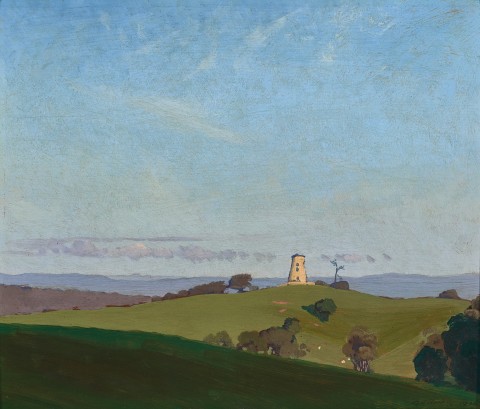THE MILL, MOUNT GILEAD, ALSO KNOWN AS THE OLD MILL, MENANGLE, 1926
ELIOTH GRUNER
oil on wood panel
24.0 x 28.0 cm
signed and dated lower right: GRUNER 1926
Macquarie Galleries, Sydney
Judge Edward, Sydney, acquired from the above in 1926
Macquarie Galleries, Sydney, by 1940 (label attached verso)
John Young, Sydney
Thence by descent
Mrs John Young, Sydney
James R. Lawson Auctioneers, Sydney, 19 November 1940, lot 161
Private collection, Sydney
Private collection, Sydney, a gift from the above in 1958
Thence by descent
Private collection, Sydney
Exhibition of Oil Paintings by Elioth Gruner, Macquarie Galleries, Sydney, 10 – 21 August 1926, cat. 15 (as ‘Mount Gilead’)
Elioth Gruner Memorial Loan Exhibition, National Art Gallery of New South Wales, Sydney, 17 April – 31 May 1940, cat. 12 (label attached verso, as ‘The Old Mill, Menangle’)
‘The Studio: Mr. Gruner’s Oil Paintings’, The Australasian, Melbourne, 21 August 1926, p. 45 (as ‘Mount Gilead’)
We are grateful to Steven Miller, Head of the Edmund and Joanna Capon Research Library and Archive, Art Gallery of New South Wales, for his assistance with this catalogue entry.
Elioth Gruner was a restless artist, uncomfortable with city life and undertook many journeys throughout Australia as a result, often for months at a time. In the first half of 1926, when The Mill, Mount Gilead, 1926 was painted, Gruner travelled from Sydney to Bellingen, inland from Coffs Harbour, down to Kelso, near Bathurst, and thence to Menangle, south of Campbelltown. In December, he would continue, heading from Bowral in the southern highlands of New South Wales to Cooma in the foothills of Mount Kosciusko. Gruner ‘worked from nature direct, living in camp or caravan for months on end, and would put up with flies, mosquitos and all the varying tortures imposed on the painter by the Australian climate, rather than succumb to what he regarded as the artificiality of the “easel painting” back in his studio.’1 The Mill, Mount Gilead is a classic example of the jewel-like scenes the artist sought to capture amidst, and in spite of, his physical privations.
Gruner was an exceptionally successful artist in his lifetime, winning the Wynne Prize for landscape painting a staggering seven times.2 His fascination with the effect of light on the landscape resulted in a number of masterworks, including Spring Frost, 1919, consistently rated as one of the most popular paintings at the Art Gallery of New South Wales. In August 1926, he held his first (and only) solo exhibition at Macquarie Galleries in Sydney, which was so admired that 26 of the 29 paintings were sold by its second day of viewing. Newspaper critics marvelled at his ‘progressive opening up new aspects of technique… brilliantly coping with some new problem.’3 However, Gruner’s star waned over subsequent decades and renewed appreciation has only ensued since curator Deborah Clark’s incisive exhibition Elioth Gruner: Texture of light held at the Canberra Museum and Gallery in 2014. His work is again seeing popularity with astute collectors as a result.
The Mill, Mount Gilead regards from afar the convict-built windmill which was erected in the 1830s on the highest ridge of Thomas Rose’s Mt Gilead farm, sited on the traditional lands of the Dharawal people. It originally had a domed roof and four large sails but fell into disrepair after wheat rust affected local crops in the 1860s. Gruner’s view is from an opposing hill and the warmth of the mid-morning sun captures the surviving stones of the tower.4 He aligns its peak with a passing row of low clouds, and perfectly counterbalances the rich greens of agriculture with the hazy blue of the background mountains, all surmounted by a cloud-whipped sky. The critic for The Australasian, who wrote of the Macquarie Galleries show, described the present work as ‘a cool and collected little study … which might be (set) in Holland, so neat and well-groomed and immaculate it is.’5 It was purchased from the exhibition by Judge Edward, who, it seems, sold it back to the Macquarie’s Director, John Young, who then gifted it to his wife Eva, herself a specialist in Australian artists, particularly Conrad Martens. The verso of this painting illustrates this connection with the distinctive Macquarie Galleries logo still affixed, designed by John D. Moore and featuring a woman standing in a doorway. The Mill, Mount Gilead has only been exhibited twice in its history and has not been seen publicly since Gruner’s memorial exhibition in 1940.
1. Daryl Lindsay, ‘Elioth Gruner: 1882 – 1939’ in Elioth Gruner Memorial Loan Exhibition, National Gallery of Victoria, 1940, n.p.
2. Gruner was awarded the Wynne Prize in 1916, 1919, 1921, 1929, 1934, 1936, and 1937
3. ‘Oil Paintings. Mr. Gruner’s Exhibition’, Sydney Morning Herald, Sydney, 11 August 1926, p.10
4. Rose’s mill tower still stands today.
5. ‘The Studio: Mr. Gruner’s Oil Paintings’, Australasian, Melbourne, 21 August 1926, p.45. The critic referred to the painting by its catalogue name of ‘Mount Gilead.’
ANDREW GAYNOR
